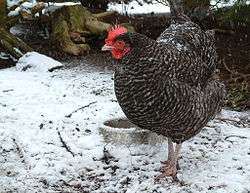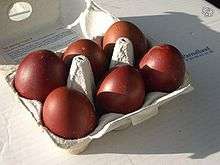Marans
The Marans, French: Poule de Marans, is a breed of chicken from the port town of Marans, in the département of Charente-Maritime, in the Nouvelle-Aquitaine region of south-western France. It was created with the local feral chickens descended from fighting game chickens carried from Indonesia and India. Those original Marandaise fowl were "improved" for the table through recombination with imported Croad Langshans. A favourite at poultry shows, it is a dual-purpose fowl known both for its extremely dark eggs and fine meat qualities.
 A cuckoo Marans hen | |
| Other names |
|
|---|---|
| Country of origin | France |
| Standard | Marans-Club de France (in French) |
| Traits | |
| Weight |
|
| Egg colour | Dark brown |
| Comb type | Single |
| Classification | |
| APA | Continental[2] |
| PCGB | soft feather: heavy[3] |
| |
History
The Marans originated in Marans, France, and were imported into the United Kingdom in the 1930s, and were later imported to the U.S. in the 2000s.[4]
Characteristics
There are 9 recognized colours in the French standard: cuckoo, golden cuckoo, black, birchen, black copper, wheaten, black-tailed buff, white and Colombian. Black copper (black with copper feathers on the neck) and cuckoo (barred feathers, giving a black and white speckled appearance) are the most common of these. Other colours not officially recognized (such as blue copper, blue, and splash) also exist.
They should have orange eyes. The shanks are usually slate or pink, the soles of the feet should always be white as Marans have white skin, not yellow. Though the original Marans could also be feather-legged birds, British breeders preferred the clean-legged version, and thus feather-legged Marans are now mainly found in France and the United States. The Australian Poultry Standard recognizes both feather- and clean-legged.[5] The American Poultry Association only recognizes feather-legged.
Some Marans have a gene that makes the shell up to 10% of the eggs weight. This is useful for unfertilized eggs, as its density typically prevents contamination and viruses from getting inside.[6] Although the shell thickness does have its advantages, it does increase chick fatality rates by 5% to 10% depending on its variety.[7] Eggs typically do better in higher humidity environments.[8] Marans eggs change in color yearly, dark brown in cooler months well a lighter shade of brown in warm months.[9]
Use

Marans hens lay around 150–200 dark brown eggs each year depending on the variety. Marans are historically a dual-purpose bird, prized not only for their dark eggs but for their table qualities as well.
References
| Wikimedia Commons has media related to Marans. |
- Standard officiel de la Marans (in French). Marans-Club de France. Accessed August 2014.
- APA Recognized Breeds and Varieties: As of January 1, 2012. American Poultry Association. Archived 4 November 2017.
- Breed Classification. Poultry Club of Great Britain. Archived 12 June 2018.
- Stalvey, Rip. "Marans and Their Dark Brown Eggs". www.chickenwhisperermagazine.com. Retrieved 7 October 2019.
- 2nd Australian Poultry Standard, 2012, published by the Victorian Poultry Breeder Association (trading as Poultry Stud Breeders and Exhibitors Victoria)
- Dark Egg needs help Hatching, retrieved 7 October 2019
- "L'oeuf angl". www.marans.eu. Retrieved 7 October 2019.
- "Marans Egg Facts and myths". Retrieved 7 October 2019.
- Stalvey, Rip. "Marans and Their Dark Brown Eggs". www.chickenwhisperermagazine.com. Retrieved 7 October 2019.
https://www.youtube.com/watch?v=WOYT4szMFDQ
https://briarwoodpoultry.weebly.com/the-marans-egg.html
https://www.muranochickenfarm.com/2013/04/marans-egg-facts.html
- http://www.marans.eu/loeufang.htm#loeufang\
WARNING! THIS NEEDS TO BE EXPANDED!